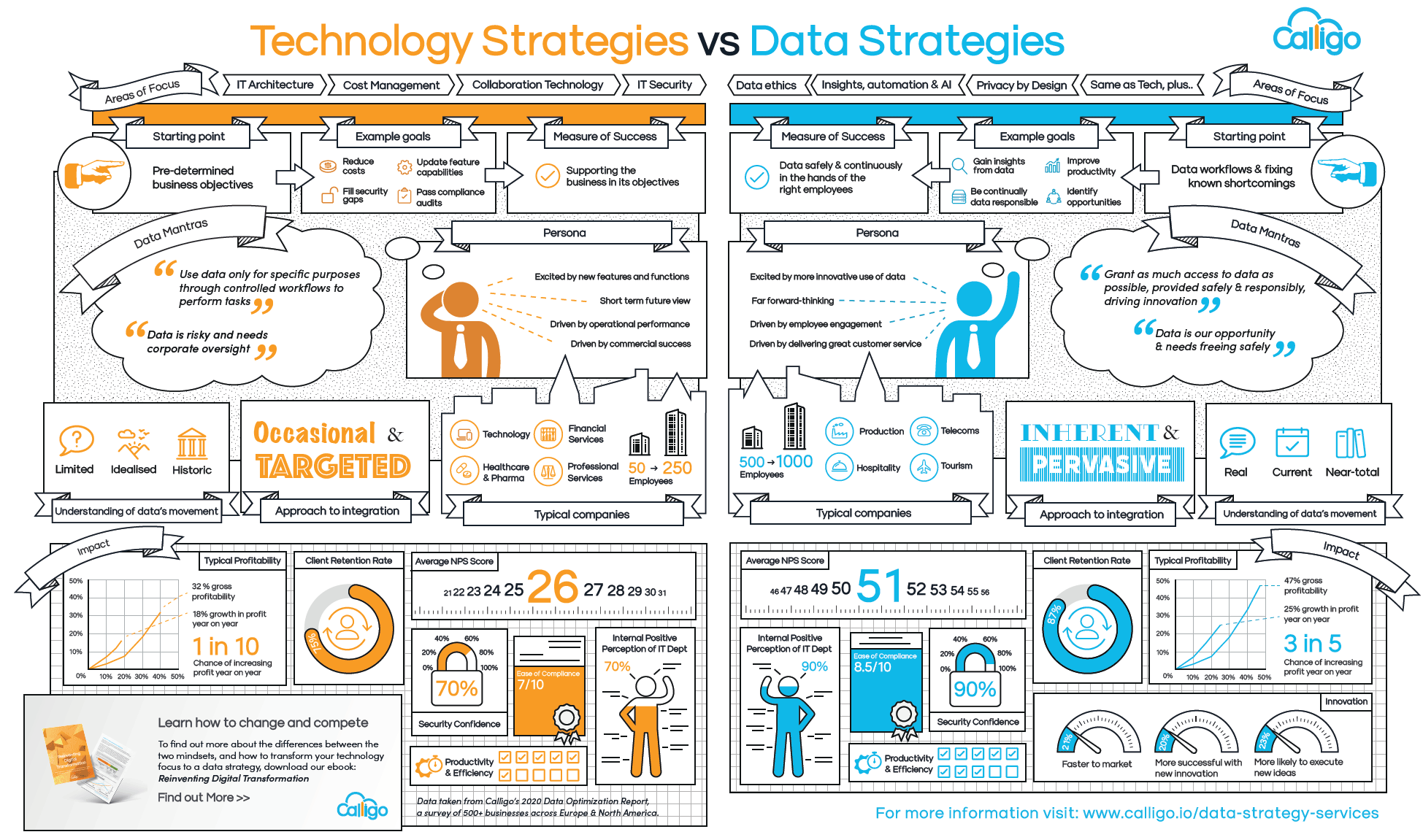2020 was a lot of things. Unexpected. Tough. Frightening. Frantic.
It was also revealing.
Most CIOs were asked to enable ways of working and doing business that they had not considered necessary before. Others had maybe always known such moves were wise, but had never been able to dedicate the time, resource or budget to such endeavours. Or, ironically, had never been able to prove the business case.
Either way, too many were caught under-prepared.
But why? When the moment of desperate need came, the solutions were available and the advantages were immediately clear – quickly solving the business case problem above. So why had they not been prioritised and invested in before?
Because most CIOs have technology strategies, not data strategies.
What’s the difference?
CIOs with technology strategies aim to address business objectives by selecting and deploying the most suitable platforms, tools and applications to deliver on them. Their focus will be on security gaps, cost reductions, efficiencies, capabilities & features, compliance and operational performance.
You may be reading that description and thinking it sounds ideal. Our research showed that 69% of CIOs would agree and find the description above quite familiar. And there is nothing technically wrong with such an approach.
But it is lacking.
A data strategy builds upon a technology strategy. It does not replace it. A data-focused CIO will still aim for everything a technology-focused one might, but then more besides. The difference is in the starting point.
As mentioned above, those who build a technology strategy will typically “take a step back” and consider the business objectives.
Meanwhile, data strategies – unsurprisingly – start with data. A data strategy requires a step even further back to consider how data enters, moves around and exits the business, what data is available to who, how safe it is, and what potential it has.
| What data do we have? | |
| Where is it, and where does it need to be? | |
| Who do we have data on? | |
| Who needs access to the data, and where are they – and where could they be? | |
| How is our data gathered and held, and is this acceptable? | |
| Is our data totally safe to use? | |
| How else could our data be used, and what might it show us or even do for us? | |
| What does our data tell us about how we serve our customers? What else could it show? |
From these investigations, key shortcomings can be identified such as resilience gaps, cost efficiencies and security weaknesses, just as with a technology strategy.
The difference is that a data strategy will also reveal how data can and cannot be accessed and what those restrictions may mean; how safe it may be to use according to privacy regulations and other compliance requirements; where productivity is hampered; what datasets are actually available and what revelations may they hold; and even how it may be put to work through automation.
Solving all these shortcomings and exposing all these possibilities creates a flexible platform from which any business objectives can be supported, however they may change and however ambitious they may be. Meanwhile, a technology strategy built strictly around pre-defined goals is instantly exposed as soon as they change.
For more on the differences between the two, check out our infographic:

Why should 2021 be the year of the data strategy?
Because 2020 was the year of remote working and data access. Organizations scrambled to not only make data available beyond the corporate network, but also had to ensure that it remained secure and compliant, and that data privacy regulations were adhered to.
For those who had to date focused on technology, rather than data and its movement through the business, this was a massive ask, particularly when it came to security. In comparison, the core ethos of a data strategy is to create a platform that puts the right data securely and safely into the hands of the people who need it, however, and wherever they need access to it.
But if 2020 opened CIOs’ eyes as to how restricted their data had been, 2021 will be the year they capitalise on its new freedom. A data strategy is a far more forward-thinking, creative, innovative, open and customer-centric attitude than a technology strategy. And ultimately a more profitable one.
The freedom of data – provided within secure but non-restrictive controls – also allows for a closer understanding of customers’ journey through your business. This includes their entry point and motivations, if and why your team struggles to serve them, and when they might be considering churning or primed for additional services.
This in turn leads to improved NPS scores and customer retention, but also a far greater internal perception of the CIO and their team for their role in delivering such capability.
How do I shift to a data strategy in 2021?
The key to a data strategy is simple to state, but can be complex to accomplish: achieve a granular visibility of every data workflow and every data interaction.
The good news is that the effort is worth the rewards, as our research shows.
greater productivity |
more capable of effective innovation |
likely to grow profitability |
The principle is that if you know every way in which your data is created, where it resides, how it moves, who uses it, where and why, then you can far easier find and solve any obstructions, inefficiencies or dangers.
And from there, every security weakness, compliance gap, productivity obstacle and cost sinkhole can be addressed, and new innovations and ambitions can be chased. All of which makes for a transformative new year.
|
|
Reinventing Digital TransformationYour guide for improving the safe and secure flow of data for greater visibility, productivity and cost efficiency
|





 Back
Back